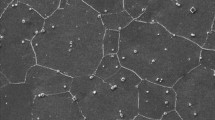Abstract
Austenitic stainless steels have a high potential for the use in separating safeguards of machine tools based on the TRIP (Transformation Induced Plasticity) effect. The problem with these materials is the high variance of the alloy composition. Therefore, the specific penetration resistance W D,spec varies significantly. The presented research analyses the impact of material specific parameters on the specific penetration resistance W D,spec and the FEA simulation of impact tests. The result of the project is the knowledge of the penetration resistance and hence the security (factor of safety) against penetration.





Similar content being viewed by others
References
DIN Deutsches Institut für Normung e.V. (2009) DIN EN 12417: Werkzeugmaschinen—Sicherheit—Bearbeitungszentren. Beuth-Verlag, Berlin
Bold J (2004) Trennende Schutzeinrichtungen für Werkzeugmaschinen zur Hochgeschwindigkeitsbearbeitung. In: Uhlmann E (ed) Berichte aus dem Produktionstechnischen Zentrum. IRB-Verlag, Stuttgart. ISBN 978-3816766971
Wittner M (2007) Leichtbau im Maschinenschutz—Umsetzungsstrategien und Konzepte. Dissertation TU Berlin
Edelstahl-Vereinigung e.V. (1989) mit Verein deutscher Eisenhüttenleute (VDEh) (Hrsg.): Nichtrostende Stähle. 2. Auflage. Düsseldorf: Verlag Stahleisen
Angel T (1954) Formation of martensite in austenitic stainless steels. J Iron Steel Inst Mai 66:165–174
Becker H, Brandis H, Küppers W (1986) Zur Verfestigung instabil austenitischer nichtrostender Stähle und ihre Auswirkung auf das Umformverhalten von Feinblechen. Thyssen Edelstähle Technische Berichte 12(1):35–54
Eichelmann GH Jr, Hull FC (1953) The effect of composition on the temperature of spontaneous transformation of austenite to martensite in 18–8-type stainless steel. Trans ASM 45:77–104
Kulmburg A, Sölkner W, Korntheuer F, Schmid H-E (1979) Das Umwandlungsverhalten komplexlegierter Stähle mit 12 bis 18% Chrom. Berg- und Hüttenmännische Monatshefte 124(9):400–406
Monkman FC, Cuff FB Jr, Grant NJ (1957) Computation of Ms for stainless steels. Metal Progress 71:94–96
Nohara K, Ono Y, Ohashi N (1977) Composition and grain size dependencies of strain-induced martensitic tranformation in metastable stainless steels. Tetsu-to-Hagane, S. 772
Pickering FB (1978) Physical metallurgy and the design of steels. Applied Science Publishers LTD, London
Uhlmann E, Bleck W, Duchstein B, Labudde T, Wildau M (2010) Leichte Werkzeugmaschinenumhausungen. Einsatzmöglichkeiten von austenitischem Edelstahl und Aluminiumlegierungen unter Kenntnis der werkstofftechnischen Parameter. ZWF—Zeitschrift für wirtschaftlichen Fabrikbetrieb 105(6):536–541
Uhlmann E, Marcks P (2006) Analysis of the design of machineguard- windows using finite element analysis. Prod Eng Res Develop 13(1):211–214
Bathe KJ (1996) übersetzt von: Peter Zimmermann: Finite-Elemente-Methode. Springer-Verlag, Berlin
Houbold JC (1950) A recurrence matrix solution for the dynamic response of elastic aircraft. J Aeronaut Sci 17:540–550
Newmark NM (1959) A method of computation for structural dynamics. ASCE J Eng Mech Div 85:67–94
MSC Software (2007) MSC.Marc theory and user information, volume A
Uhlmann E, Duchstein B (2009) Trennung leicht gemacht. Werkstatt und Betrieb 142(3):55–57
Acknowledgments
We express our sincere thanks to the Deutsche Forschungsgemeinschaft (DFG) for funding this research.
Author information
Authors and Affiliations
Corresponding author
Rights and permissions
About this article
Cite this article
Uhlmann, E., Duchstein, B. Austenitic stainless steel for separating safeguards: development of an FEA-model for the simulation of impact tests in reference to material specific parameters. Prod. Eng. Res. Devel. 5, 307–313 (2011). https://doi.org/10.1007/s11740-011-0307-0
Received:
Accepted:
Published:
Issue Date:
DOI: https://doi.org/10.1007/s11740-011-0307-0




